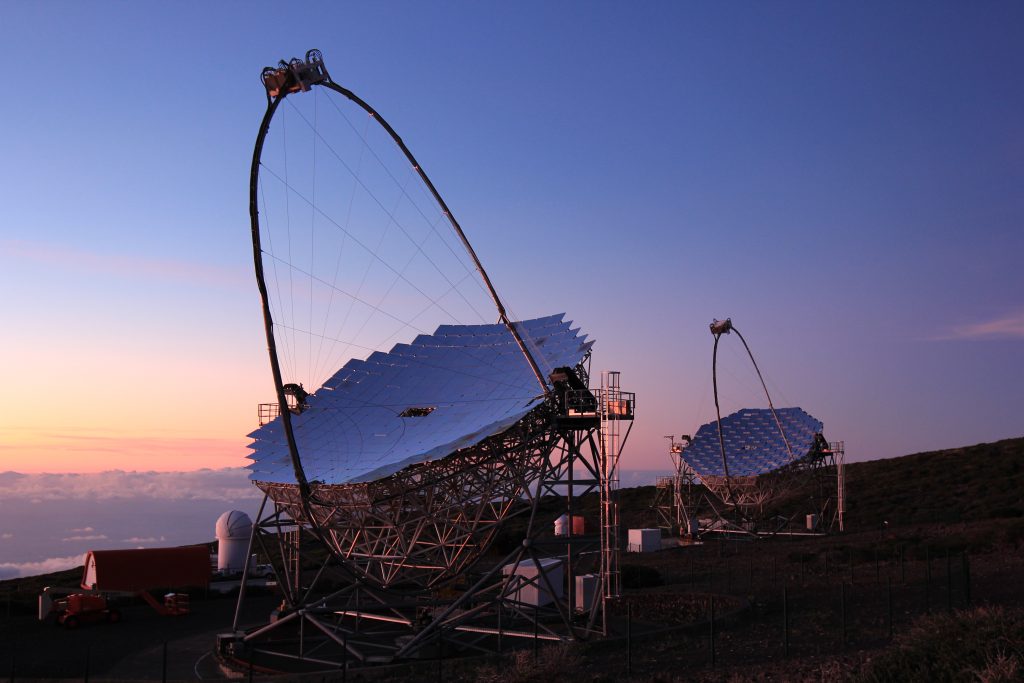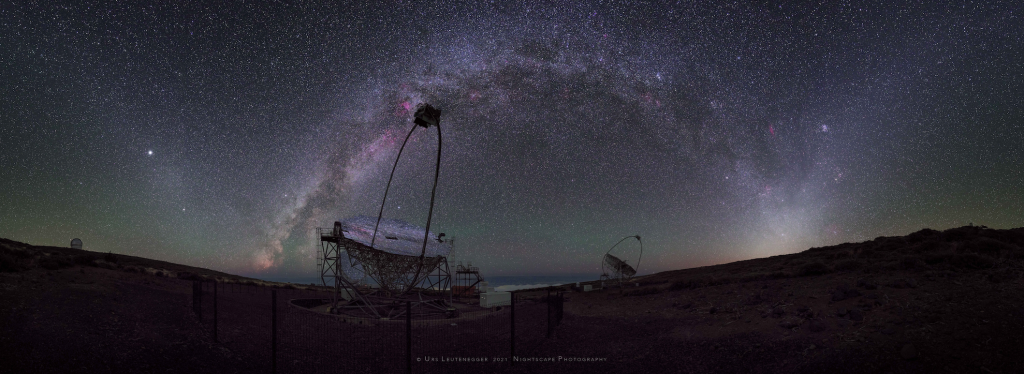Institute for Cosmic Ray Research, The University of Tokyo

An international team of scientists from the MAGIC collaboration, using a system of two 17m diameter telescopes on the Canary Island of La Palma, have observed the center of the Milky Way for 233 hours in search for very high energy gamma-ray lines that could originate from particle dark matter. Those observations did not turn up a sign of the elusive dark matter, but help constrain possible properties of candidate particles. The scientists report on their result in the prestigious journal Physical Review Letters.
Although there is clear evidence from a wealth of astronomical observations – including the rotation curves of galaxies, gravitational lensing, and the formation of structure throughout the Universe – that the majority of all matter in the Cosmos is of a very different type than the matter we encounter in our everyday lives, the exact nature of that “dark matter” has so far eluded all attempts to be traced. Physicists presume that the dark matter may consist of not yet discovered particles from beyond the Standard Model of physics, and may thus be important pointers towards a deeper understanding of Nature as a whole, if identified. The hunt for those particles has been on for decades, and scientists all over the world employ powerful particle accelerators, sensitive experiments in deep underground caverns, and huge telescopes to finally bring light to that dark corner of reality. Those efforts, however, are very challenging precisely due to the elusive nature of the candidate particles: they are presumably much heavier than the particles we find in the nuclei of the atoms that are the basic building blocks of ordinary matter, and interact at most via gravity and perhaps through the so-called weak force. What they however lack is the basic property due to which we normally identify and study ordinary matter: the direct ability to absorb or emit light. Due to that, any possible signature of the dark matter is hard to trace, and hard to discriminate against backgrounds e.g. due to stellar explosions and other more or less ordinary processes in the Universe. But there may still be a chance, as some dark matter particles might interact with each other, and eventually produce unique signatures like the emission of very energetic light.
For the study reported here, scientists employed the highly sensitive MAGIC telescope system located at the Roque de Los Muchachos observatory on the Canary Island of La Palma (Spain, Europe). This instrument consists of two telescopes, each having a primary mirror with a diameter of 17m and a highly sensitive photodetection camera. The telescopes capture brief flashes – the Cherenkov light – that are produced when light of energies billions to trillion times larger than the energy of the visible light (teraelectronvolt, or TeV-energies) hits the atmosphere of the Earth. This way, MAGIC can provide ground-based observations at those high energies, although such highly energetic photons do not penetrate our atmosphere. The very high sensitivity of the MAGIC system at TeV-energies is crucial, as the mass of the dark matter particles – and thus the light that may be produced in their rare interactions – may well be around those energies. In order to be able to distinguish any possible signal from dark matter interactions from already known astrophysical phenomena, the MAGIC scientists specifically searched for gamma-ray “lines” – light emitted within a very narrow and specific range of energies. Quite similar to the lines in the fingerprints of a human, which can identify any single human in a crime scene investigation, such TeV-lines would be a giveaway for interactions of particles much heavier than anything known within the Standard Model, and can thus be considered a “smoking gun signature” for dark matter. The team decided to point the MAGIC telescopes at the center of our home galaxy, the Milky Way, because this region is strongly suspected to harbor a large concentration of dark matter. Scrutinizing a total of 223 hours of observational data collected over a timespan of seven years, from 2013 to 2020, the scientists did not find any line-like emission.
Tomohiro Inada, a postdoctoral researcher affiliated to ICRR and University of Tokyo, Japan and leading author of this effort, says: “We observed around the Galactic Center of the Milky Way, which is one of the most fascinating sources in the field of astrophysics, to search for tiny signals from dark matter. Sadly, no signals were found but our results tested one of the well-motivated new particle models beyond the standard model, so-called supersymmetric (SUSY) particles, and we showed the potential of our telescope for such a fundamental physics case”.
Daniel Kerszberg, Ramon y Cajal fellow at IFAE, Barcelona, Spain, and corresponding author of this work, adds: “The center of the Milky Way is a region crowded with astrophysical sources which also emit high-energy TeV photons, therefore we had to be very careful with the statistical tools we used to search for a possible dark matter signal and obtain our results”. This result now will help theoretical physicists to further constrain possible properties of dark matter particles and the physics models from which they may originate. Says Moritz Hütten, postdoctoral researcher at ICRR and the University of Tokyo, Japan and one of the corresponding authors: “The upper limits on the maximum possible interaction strength between dark matter particles strongly depend on the density of dark matter particles we expect at the center of our Galaxy. Therefore, we tested our data for various assumptions of the distribution of dark matter in the inner Milky Way.” Kazunori Kohri, an associate professor at the High Energy Accelerator Research Organization (KEK) who participated in the theoretical interpretation of the data, says: “Any dark matter model that couples directly to gamma rays, rather than through quantum corrections, could be severely constrained by this analysis,”
In the future, the applied technique will enable even more sensitive searches with MAGIC and the new generation of very high energy gamma-ray experiments, like the Large Size Telescopes (LST) from the Cherenkov Telescope Array (CTA), that are currently being constructed next to the MAGIC telescopes. As in any criminal investigation, narrowing down the list of suspects is often the first step towards solving the mystery!

<Information>
Paper:Physical Review Letters (to be published on February 10)
Title:Search for gamma-ray spectral lines from dark matter annihilation up to 100 TeV towards the Galactic Center with MAGIC
Authors:MAGIC Collaboration: H.Abe, S.Abe, K.Asano, J.Baxter, Y.Fukazawa, D.Hadasch, M.Hütten*, R.Imazawa, T.Inada*, D.Kerszberg*, Y.Kobayashi, H.Kubo, J.Kushida, D.Mazin, T.Nakamori, K.Nishijima, K.Noda, Y.Ohtani, T.Oka, T.Saito, S.Sakurai, M.Strzys, Y.Suda, M.Takahashi, R.Takeishi, K.Terauchi, M.Teshima, I.Vovk, T.Yamamoto, N.Hiroshima, K.Kohri, et al.
URL : https://journals.aps.org/prl/abstract/10.1103/PhysRevLett.130.061002





